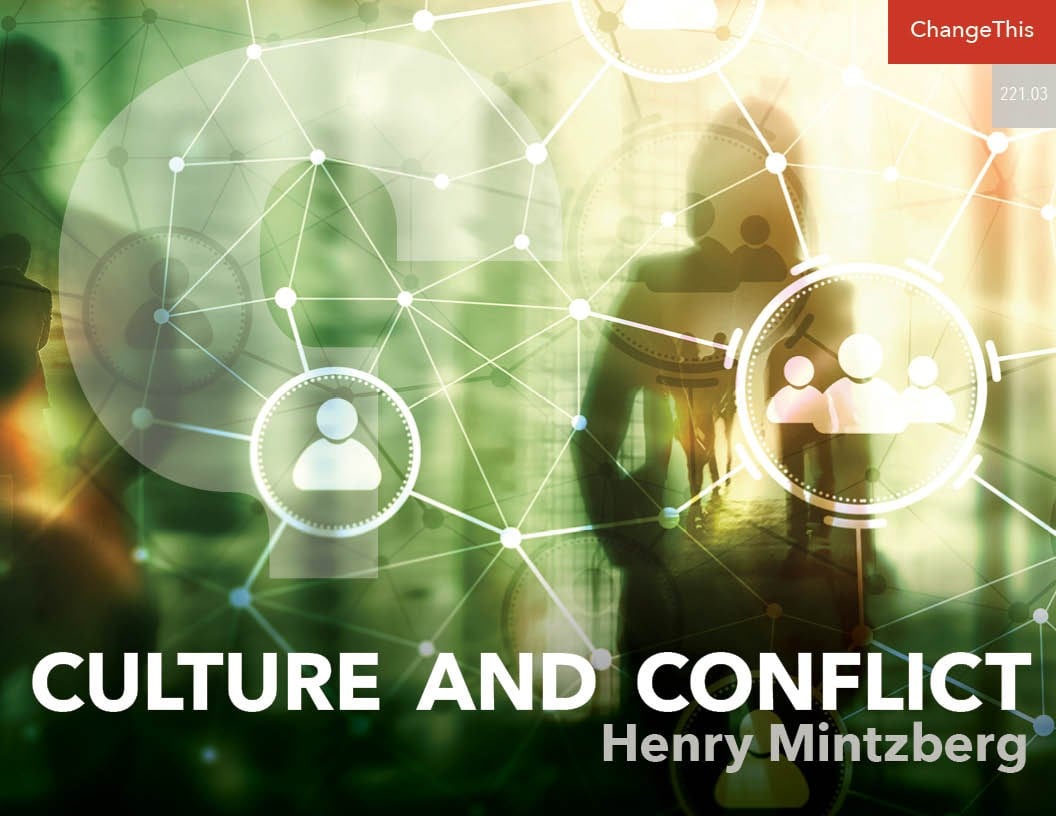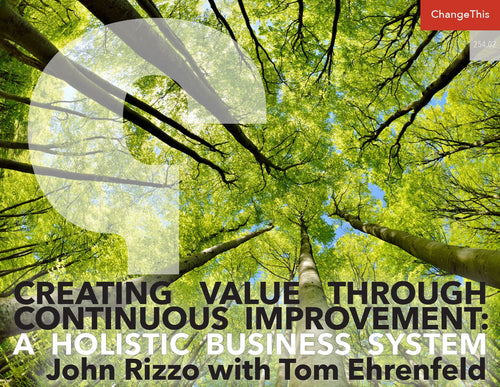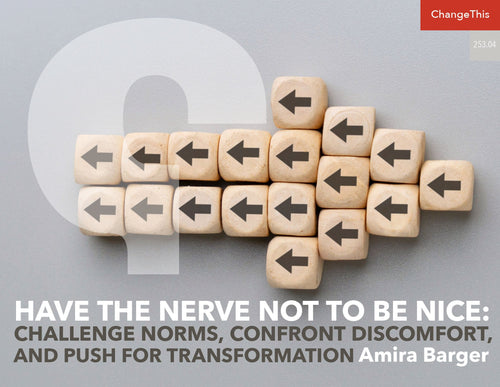Culture and Conflict
Every organization has a culture, its way of doing things.
A research lab just doesn’t feel like a bank, or, for that matter, sometimes one research lab from another. If structure is the skeleton of the organization and systems are its flesh and flows, then culture can be its spirit. Can be, because some cultures are ordinary, indistinct, like several supermarket chains where I live. (They can be described as having an industry culture. Likewise, there are occupational cultures, such as in engineering, and, of course, nations are often described as having their own cultures—say, German compared with Italian.)
Organizations with indistinct cultures are like people with indistinct personalities—they are more flesh and bones than heart and soul. But some organizations are distinct: they have their unique ways of doing things. This can render their culture compelling, thus infusing their structure with soul, much as a dye infuses a clear
liquid with color. The story is told of three bricklayers. When asked what they do, one says that he is laying bricks, a second that he is building a church, the third that he is creating a monument to the almighty. It is in the third where the people pull together, as members of a community more than just employees who go to work. We can call this collective spirit communityship—a word we can use to get past our fixation on leadership.1
Synergy is a word for this phenomenon, the 2 + 2 = 5 concept: that the parts together produce more than they would apart. Organizations generally function more effectively when people work in compelling cultures that reduce their status differences. Whether you are sweeping the floors or managing the office, you are recognized for doing your part to make the organization great.
People who are engaged with their organizations describe how alive they feel, how creative and emboldened. They talk about how much they’ve grown through their work and how much they look forward to entering the organization each day, even when things are difficult or stressful.
While the people of other organizations may look outward to what comparable ones are doing, the people in these organizations look inward to the enthusiastic pursuit of its own mission. This could explain why some sports team with no star players come out of nowhere to win a championship: the regular players just played together with exceptional energy: 2 + 2 = 5. Money can buy stars, but it can’t buy conviction. Likewise, sometimes we walk into a hotel or a school and the place just feels different. The people are attentive, responsive, and energized; they serve well because they themselves are respected by their own management.
A TALE OF TWO HOTELS
There is a hotel in the north of England that I have been obliged to stay at from time to time—a corporate place with little spirit. I recall a high turnover of staff, and one time, back in the days of landlines, when they charged ten dollars per minute for calls to Japan that cost them about a penny. On one occasion, I left that hotel to check out another one in the English Lake District, for our management program. The minute I entered that hotel, I could feel the energy of the place. It was loaded with soul: beautifully appointed, perfectly cared for, with a genuinely attentive staff (a real smile instead of some grin from a “greeter”).
What does it mean for an organization to have a soul? You know it when you see it;
you feel it in every detail. I asked a waiter about hiking trails nearby. He didn’t know so he fetched the manager, who came right over to tell me, in detail. I asked a young woman at reception how long she had been here. Four years, she said proudly, and then rattled off the tenures of the senior staff: the manager fourteen years, the assistant manager twelve years, the head of sales almost as long.
Most people—employees, managers, customers—wants to care, given half a chance. If we human beings have souls, why can’t our hotels, hospitals, and schools, let alone our banks and phone companies?
THE DEVELOPMENT OF A COMPELLING CULTURE
There are three stages in the development of a compelling culture: founding, diffusing, and reinforcing.
Stage 1: Founding with a sense of mission, often around a charismatic leader. These can create something special, exciting. This is much easier to do in a new organization, unconstrained by procedures and traditions, when people are able to develop close personal relationships—to pull together. In contrast, doing so in an existing organization, with the beliefs and procedures already established, is far more difficult, although sometimes a major event—the arrival of a charismatic leader, a crisis demanding major change—can enable the organization to suspend its usual ways and build culture anew.
Stage 2: Diffusion of the beliefs through precedents and stories. As the members collaborate in making decisions and taking actions, precedents are established that can become traditions. Stories are told about inspiring events; the best of which become sagas, to use the Nordic label, and these combine to establish a unique history. Gradually the organization gets infused with value, to use Philip Selznick’s celebrated expression, to become what he called an institution, a system with a life of its own, having “acquire[d] a self, a distinct identity.”3
Stage 3: Reinforcement of the culture through identifications and socialization. People joining such an organization do not enter a random collection of individuals, but a living system, with its traditions and stories. To remain, they must come to identify with all this—become loyal members. Such organizations use interpersonal processes of socialization, or indoctrination, to institutionalize the commitment of its new members, as well as to reinforce that of the existing ones— for example, with social events of various kinds.
This is how a compelling culture is built—slowly, patiently. Once done, however, it can be difficult to change. But not to kill.
THE INTRUSION OF CONFLICT
My Oxford dictionary defines conflict as “serious disagreement” and politics as “activities concerned with gaining or using power within an organization or group.” These two terms go together: disagreements arise when different actors try to gain or use power. Hence both will be used here.
Every organization experiences conflict, more or less, even if this is just some clash of personalities. Usually this is limited so that people can get on with things, but not always. Buy a condo and attend the owners’ meetings. One group may be determined to spruce up the place to increase its market value while another may be insistent on minimizing the fees. They may simply argue, but in some condos, this becomes cold war.
If a compelling culture pulls people together in an organization (centrifugal), then the clashes of conflict pull them apart (centripetal). Indeed, conflict itself can take a compelling culture apart, just as a compelling culture can bring conflicting parties together. This is a bit like that game where scissors cut paper, rocks crush scissors, and paper covers rocks.
For people trying to get things done in an organization, conflict and politics can feel intrusive. After all, if organizing is about attaining order, conflict is disorderly. But in the larger scheme of things, conflict is as natural as culture.
Like bees, we are naturally collaborative creatures who can be highly competitive. Our cultures pull us together and our conflicts pull us apart. When we disagree, we might “play politics,” meaning acting underhandedly, outside the formal structure. If this sounds like some sort of game, it can in fact be seen as a whole set of them, some of which challenge the legitimate power of authority, expertise, culture, or else break down formal structure, while others use some legitimate kind of power in illegitimate ways.
CONSTRUCTIVE CONFLICT
Little space need be devoted to the divisive and costly role of conflict in organizations:
we understand how much useful energy can be wasted in playing political games. What does deserve space, however, because it is less widely appreciated, is how conflict and especially politics can be constructive.
In general, politics can be necessary to correct certain deficiencies in an organization’s legitimate systems of influence. Put differently, politics, whose means are (by definition) illegitimate, can be used to pursue ends that are legitimate—as when a whistleblower reveals the abusive behavior of a boss. We can elaborate on this in two specific points.
First, politics as a system of influence can act in a Darwinian way to ensure that the strongest members of an organization are brought into positions of leadership. Because authority favors a single chain of command, weak leaders can suppress strong subordinates. Politics, on the other hand, can provide alternate channels of communication and promotion, as when it enables someone to leap over a weak boss. Moreover, since dealing with conflict is a key part of the manager’s job, political games can demonstrate a person’s potential for leadership. The second-string players may suffice for the scrimmages, but better to have the best meeting the competition. Political games not only suggest who these players are, but also help to remove their weaker rivals from contention.
Second, politics can promote different sides of an issue when the legitimate systems of influence promote only one. It can thus force an organization to face changes that have been resisted by its vested interests. The system of authority, by aggregating information up the hierarchy, tends to advance a single point of view, often the one already known to be favored by the people in authority. The system of expertise can concentrate power in the hands of established experts, with their entrenched paradigms and protocols, while a compelling culture is rooted in firmly established beliefs. In the face of all these obstacles, politics can work as an “invisible hand”—more to the point, an underhand—to promote necessary change.
CULTURE AND CONFLICT
Culture and conflict coexist in organizations, sometimes to challenge each other—pulling together versus pulling apart—but also to keep each other in check. A culture of inclusiveness can constrain the intrusiveness of conflict, just as the intrusiveness of conflict can loosen a culture that has become too inclusive.
As various actors pursue their self-interest, the centripetal force of conflict that could explode an organization can be restrained by the centrifugal force of culture. Individuals can challenge each other internally yet present a united front externally once they have made their decisions. Likewise, a culture of overworked beliefs that is imploding can be pulled open by the explosive force of conflict. Hence the dynamic balance necessary in organizations can be maintained by the tension between culture and conflict.











































